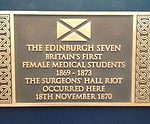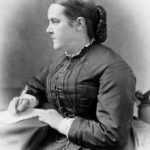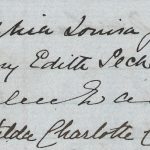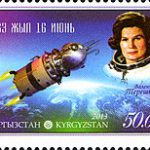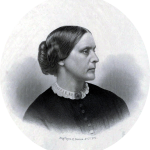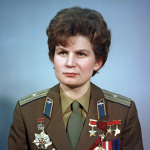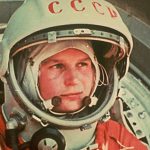- Surgeons’ Hall Riot Plaque
- Sophia Jex-Blake
- Matriculation Signatures
Name: Edinburgh 7 (Sophia Jex-Blake, Isabel Thorne, Edith Pechey, Matilda Chaplin, Helen Evans, Mary Anderson, and Emily Bovell)
Born: Multiple Dates Died: Multiple Dates
What they did: Forced the University of Edinburgh to accept them into medical school through numbers and perseverance.
Facts:
- Sophia Jex-Blake applied to study medicine in Spring 1869 but was told the University couldn’t make necessary accommodations for one lady.
- Sophia figured that if the University wouldn’t be willing to make necessary accommodations for one woman, maybe they would reconsider if there were more women!
- She put ads in newspapers to find more women to join her.
- Altogether, five women submitted a second application that summer. By the time it was approved by the University Court, the group had grown to 7.
- To start school all had to take an exam, out of the 152 total candidates who took the exam in October, four of the women ranked in the top 7 places.
- On November 2 of that year, the University of Edinburgh became the first British University to accept women.
- They were not allowed in the same classes as male counter-parts, some teachers refused to teach them, some professors would not give them credits for their classes, and they had to pay more tuition.
- in 1870 Edith Pechey ranked 1st in her first physiology and chemistry exam which should have gotten her a scholarship but due to growing resentment towards the women from the faculty and the concern of upsetting the male students Edith and other qualifying women were denied the scholarship.
- The women suffered much abuse for their studies, including being called whores, mean threatening them, having their property damaged and more.
- It all came to a head when the women in November of 1870 went to take an anatomy exam in Surgeons’ Hall.
- The women found that Nicholson Street was blocked by a crowd made up of hundreds of people. As the women approached, they were pelted with garbage and the crowd shouted at them.
- When they tried to enter Surgeons’ Hall, the gates were slammed in their faces. They instead faced the crowd until a sympathetic student finally opened the gates. This event is now known as the Surgeons’ Hall Riot.
- Sophia claimed that the crowd had been encouraged by a teaching assistant, who then successfully sued
her for defamation. - The riot gained the women widespread publicity and won them support, even amongst some male students who were shocked by the riot. The supportive male students STEPPED THE FUCK UP and began escorting the woman and acting as bodyguards.
- Some of their supporters formed a General Committee for Securing a Complete Medical Education for Women which had over 300 members including Charles Darwin and more women joined their classes
- Despite all of this, the University refused to award the women their degrees in 1873. This decision was not only upheld by the Court of Session which is the supreme civil court of Scotland, but the court also ruled that the women shouldn’t have been accepted into the University in the first place.
- Where did all the women go?
- Sophia Moved to London and established the London school of Medicine for Women in 1874. She eventually returned to Edinburgh in 187 and opened her own practice there becoming their first women doctor. She then helped also create the Edinburgh School of Medicine for Women. Sophia was also an LGBTQ figure. Her partner was Dr. Margaret Todd who was an incredible lady in her own right and helped to coin the term isotope!
- Edith practiced in Leeds before becoming a senior medical officer at a women and children’s hospital in Bombay (modern-day Mumbai.) eventually she was also appointed to the senate at the University of Bombay.
- Isabel Attended Sophia’s school and became its secretary. She left the medical field to help run the school for almost 30 years. Her daughter became a surgeon.
- Emily got her MD in Paris, worked at New Hospital for Women in London for three years the moved to Nice to work with helping with TB. She was also awarded the Officer of the Order of Academic Palms by the French government for her contributions to medicine (an award women rarely won).
- Helen married and had 3 children, she became a member of the executive committee for the Edinburgh School of Medicine for Women.
- Matilda married then moved to Tokyo and helped found a school of midwifery. She later studied at the London School of Medicine for Women and received her MD in Paris in 1879, eventually setting up her own private practice.
- Mary finished her studies at the London School of Medicine for Women. She received her MD in Paris and worked at London’s New Hospital for Women until 1895.
- Valentina’s Stamp
- Valentina in uniform with honors, 1969
- Valentina in her Spacesuit before flight
Name: Valentina (Valya) Tereshkova
Born: 1963 Died: Not dead yet (said in Monty Python accent)
What she did: First women in space!
Facts:
- Started school at 8, left school at 16 to work, but finished via correspondence courses.
- She became interested in parachute jumping after joining the Yaroslavl Air Sports Club. She made her first jump in 1959 at age 22.
- In 1961 she volunteered for the Soviet Space program.
- Although she did not have any experience as a pilot, she was accepted into the program because of her 126 parachute jumps.
- At the time, cosmonauts had to parachute from their capsules seconds before
they hit the ground on returning to Earth. - Other Qualifications included that they be under 30 years of age, under 5 ft 7 in tall, and under 154 lb in weight.
- At the time, cosmonauts had to parachute from their capsules seconds before
- From more than 400 applicants Valentina and four other women received 18 months of training.
- Which included tests to determine how she would react to long periods of time being alone, to extreme gravity conditions and to zero-gravity conditions.
- Weightless flights, isolation tests, centrifuge tests, rocket theory, spacecraft engineering, 120 parachute jumps and pilot training in MiG-15UTI jet fighters.
- In November 1962, after which four remaining candidates were commissioned Junior Lieutenants in the Soviet Air Force.
- The State Space Commission nominated Tereshkova to pilot Vostok 6 at their meeting on 21 May. Tereshkova was exactly ten years younger than the youngest Mercury Seven astronaut, Gordon Cooper.
- On the morning of 16 June 1963, Valentina and her backup Solovyova were both dressed in spacesuits and taken to the launch pad by bus. Following the tradition set by Gagarin, Tereshkova also urinated on the bus tire, becoming the first woman to
do so. - After a two-hour countdown, Vostok 6 launched faultlessly, and Tereshkova became the first woman in space.
- Her call sign in this flight was Chaika (English: Seagull) later commemorated as the name of an asteroid, 1671 Chaika.
- She orbited the earth 48 times and spent almost three days in space.
- With a single flight she logged more flight time than the combined times of all American astronauts who had flown before that
date. - Tereshkova also maintained a flight log and took photographs of the horizon, which were later used to identify aerosol layers within the atmosphere.
- Tereshkova was honored with the title Hero of the Soviet Union. She received the
Order of Lenin and the Gold Star Medal. She became a spokesperson for the Soviet Union and while fulfilling this role, she received the United Nations Gold Medal of Peace. - After her mission, she was asked how the Soviet Union should thank her for her service to the country. Tereshkova asked that the government search for, and publish, the location where her father was killed in action. This was done, and a monument now stands at the site in Lemetti—now on the Russian side of the border.
- Tereshkova studied at the Zhukovsky Air Force Academy and graduated with distinction as a cosmonaut engineer. In 1977 she earned a doctorate in engineering.
- She has held numerous political positions and is still a very recognized figure in Russia.
- Tereshkova was invited to Prime Minister Vladimir Putin’s residence in Novo-Ogaryovo for the celebration of her 70th birthday. While there she said that she would like to fly to Mars, even if it meant that it was a one-way trip.
Quotes:
“If women can be railroad workers in Russia, why can’t they fly in space?”
“Once you’ve been in space, you appreciate how small and fragile the Earth is.”
